You may not find this terribly rewarding unless you're included here, so this is a good time for casual and random browsers to turn back before they get too caught up in the sweep and majesty of the proceedings and can't let go.
We've finally got semi-sorted out on a rental car, a half-size Fiat Panda with a stick shift (which required a little practice). The real problem, it transpired, was that we were never able to find a road map and the rude countryside roads were badly marked, if marked at all, with just the local hamlets the names of which were entirely opaque for us. The drive to Palestrina was nearly hopeless, and the drive home, racing nightfall, was a nightmare.
An awkward road trip to Palestrina
Nonetheless, all fans of the church composer Giovanni Pierluigi da Palestrina (1525-1594), called 'the leading composer of late 16th-century Europe', would think it disloyal to pass up an opportunity to visit the great chap's birthplace.
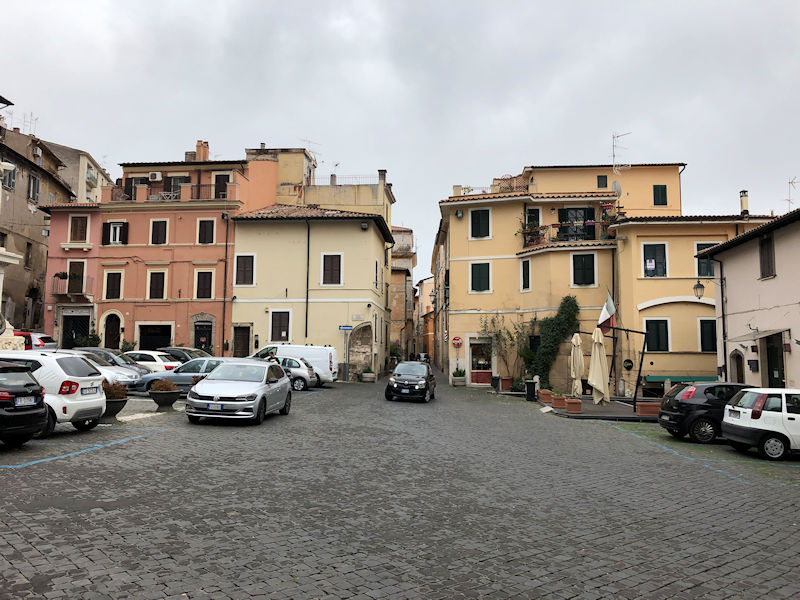
This is the Piazza Regina Margherita near the top of the hillside town, squatting on what was once the Forum of the early city of Praeneste, allegedly founded by Ulysses or somebody equally cool, with evidence of occupation from the 8th century BC. Over centuries it was allied with Rome sometimes, warring with Rome at others, as in the Latin War of the 370s BC. Archaeology has shown evidence of brisk trading with both Etruscans and the Greek city states in Italy, as well as much farther afield.
Its inhabitants were offered Roman citizenship in 90 BC, during the Social War, but in the Marius/Sulla civil war, they sided with Marius, who was blockaded in the town, and when Sulla took the town in 82 BC, Marius killed himself but the male population of Praeneste were massacred and replaced by a military garrison.
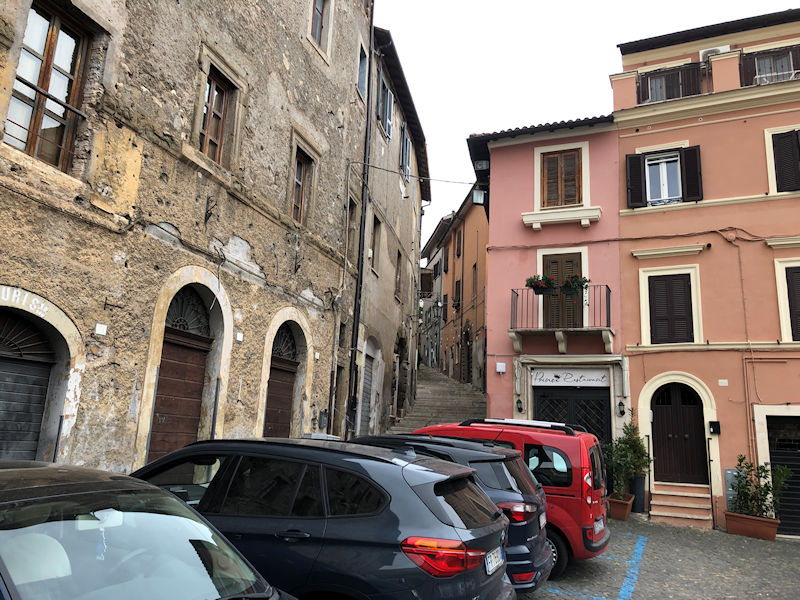
Nevertheless, the revivified city flourished and became a favorite summer getaway for rich Romans, whose villas proliferated in the neighborhood under the Empire. But its main claim to fame was the Sanctuary of Fortuna Primigenia (a favorite of parents bringing their first borns to assist them in surviving infancy), founded in 204 BC, built upon five enormous terraces up the hillside, probably the largest sanctuary in Italy.
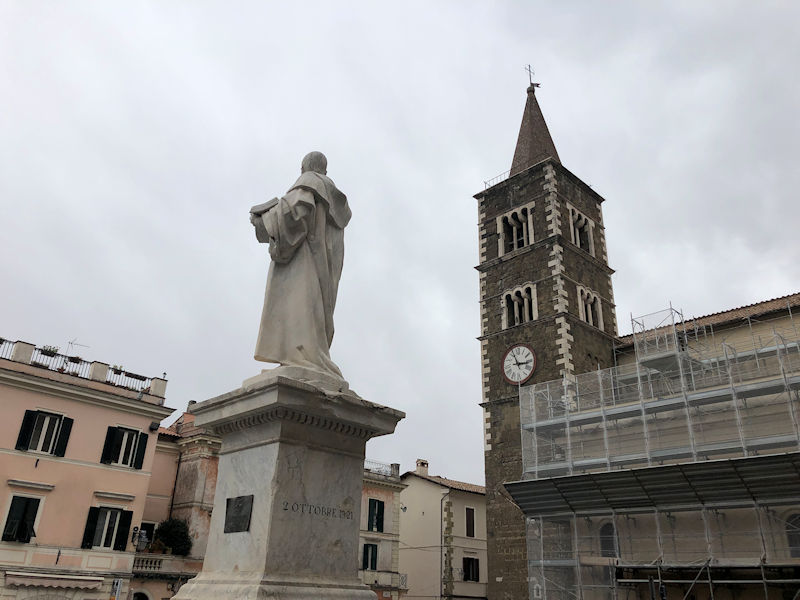
As we wriggle out of our tiny Panda, we are confronted by the belltower of the Cathedral of St Agapito and a well-deserved statue of Giovanni Pierluigi da Palestrina (1525-1594), the preeminent composer of 16th century polyphonic church music, who served as organist to the Cathedral here from 1544 to 1551 before moving to Rome, where he was choirmaster of the Cappella Giulia at St Peter's Basilica, then at St John Lateran, then Santa Maria Maggiore, then back to St Peter's in 1571 for the rest of his life. His published compositions (according to Wikipedia) include 105 masses, 68 offertories, 140 madrigals (half of which are secular), more than 300 motets, 72 hymns, 35 magnificats, 11 litanies, and 4 or 5 sets of lamentations. [We're listening to a CD of two of his masses as we write this.]
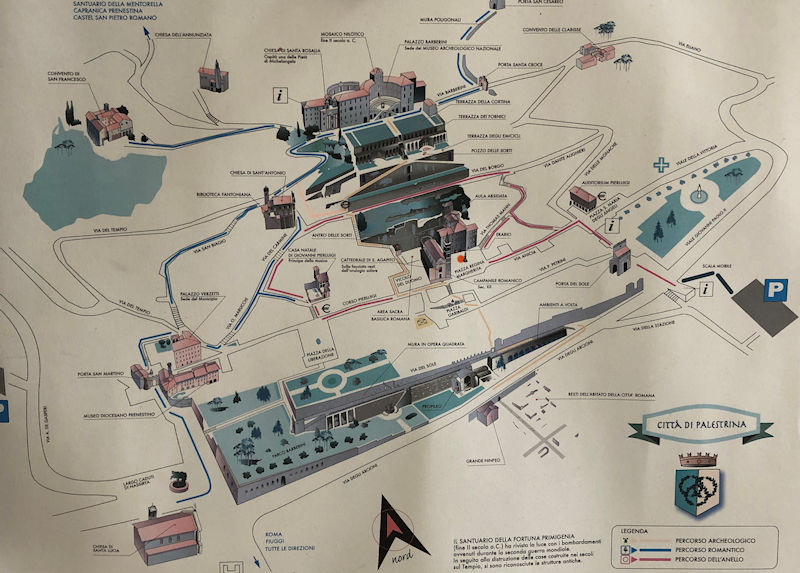
Here's the general layout of what we've come to see. We're presently in the Piazza with the red dot, once the Roman Forum, adjacent to the Cathedral and a former four-nave basilica, now a starting point for the museum complex. We were unaware at the time, but to get to the really good stuff we were going to have to march up to the main part of the museum, which we did, with but few complaints.
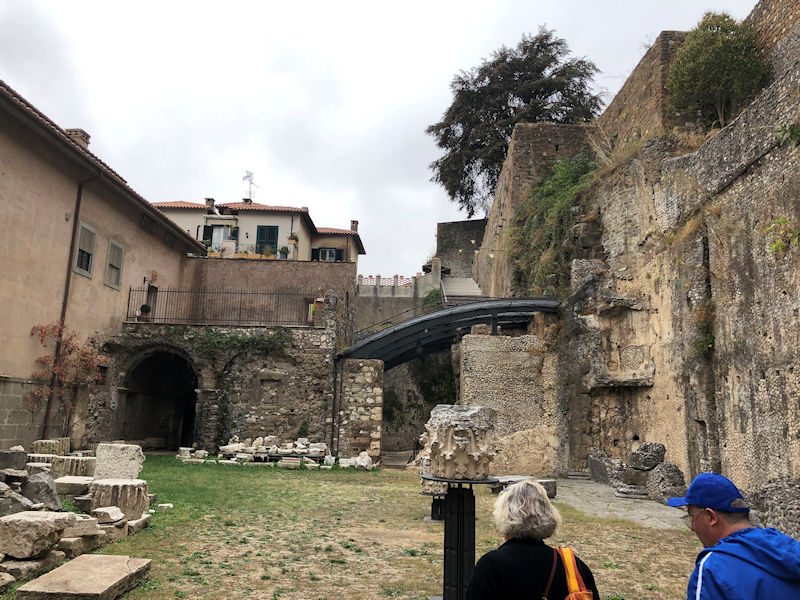
We're getting the guided tour of the 'Complesso degli Edifici del Foro di Praeneste' based on the old Forum, the part of the archaeological museum centered on the remains of this four-part basilica, originally roofed (with one of its two nymphaea ahead in the centre, shrines to water nymphs usually including a spring and/or reservoir, and in this case with a badly damaged floor with a mosaic of fishes).
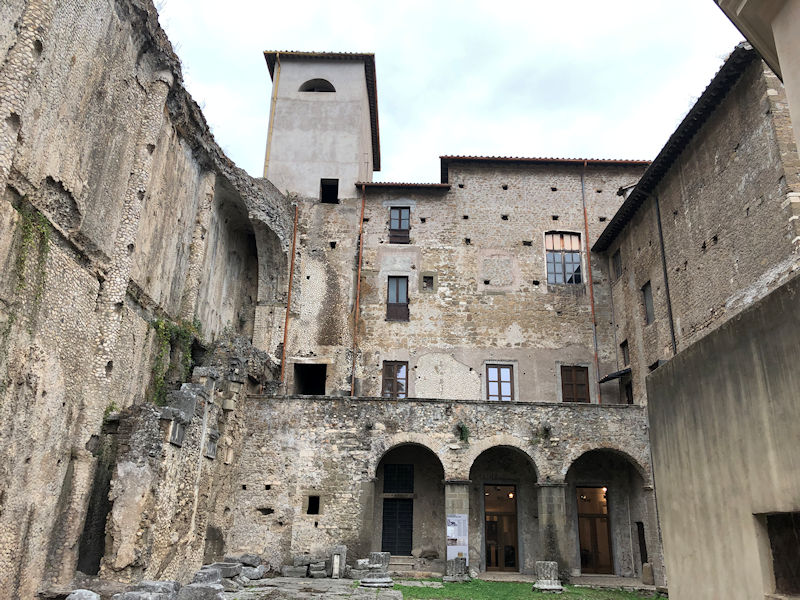
One of the most interesting things about these ruins here, and much of what remains for us farther up the hill, is that nearly all of the ancient temple was buried under more than two millennia of accumulated flotsam and jetsam of daily lives, but American bombers exposed the city's great past when they blew the daylights out of the place in January 1944.
It appears unknown, by the way, when the classical name of 'Praeneste' (perhaps referring to its location overlooking the Alban Hills) was replaced or transmogrified itself into the present 'Palestrina', sometime in the Middle Ages certainly. By the time the Roman Colonna family inherited the town as a fiefdom in the 11th or 12th century, it was known as Palestrina.
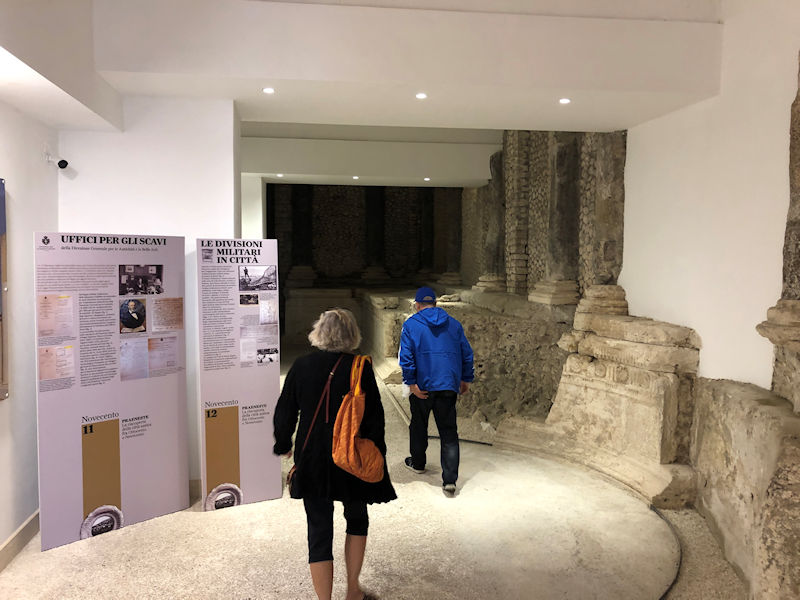
This part of the museum is focused more upon the archaeological work that was carried out, both before and after the bombing, so we're inclined to hurry up a bit.
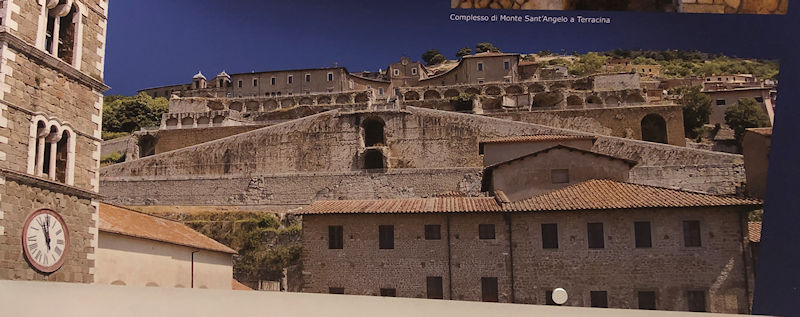
This is part of a poster looking straight up at what we have in store for us in our immediate future. At the top is the Barberini Palace, way way up there.

But first, the Cathedral, properly the Cattedrale di Sant'Agapito martire, dedicated to the 16 year old son of a noble family in town who refused to renounce his Christianity; he was tortured and tossed to wild beasts in the arena here, supposedly during a brief Christian-persecution under the Emperor Aurelian in about AD 274. Naturally, the wild beasts refused to inconvenience him at all, so he was beheaded.

This was the site of a Roman building from the 6th century BC, apparently a temple to Jupiter, which was transformed into a Christian temple at some point after Constantine's legitimation of Christianity in AD 313. It was enlarged in Romanesque style in the 12th century and consecrated in 1117, and survived the destruction of much of Palestrina by Pope Boniface VIII Caetani in his disputes with the Colonna family in 1298. It was badly damaged, however, during civil conflicts in 1437 between (again) the Colonna family and the forces of Pope Eugene IV, affecting part of the façade (as seen above) and much of the belltower, carried out by the papal commander Cardinal Vitelleschi (who stole the bronze door and marble jambs for his own hometown).
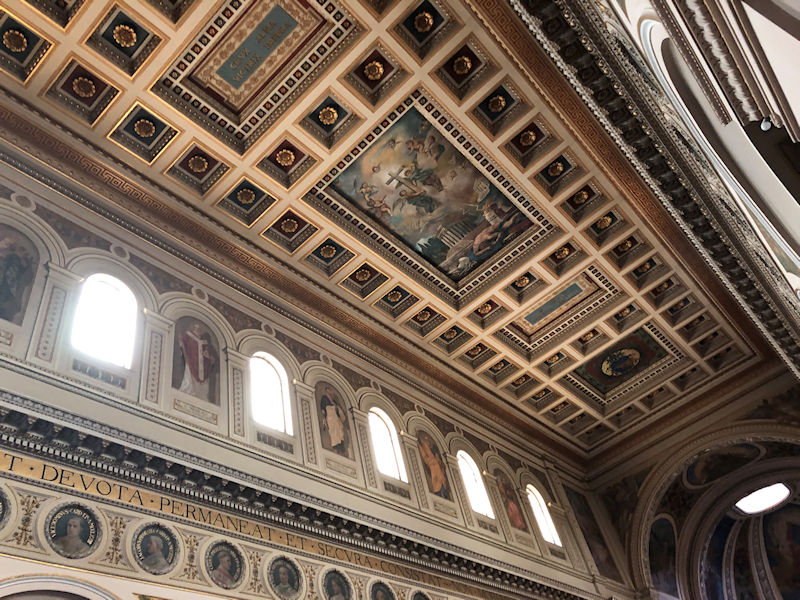
Further alterations and enlargements were made in 1706, with more recently a thorough renovation that was inaugurated in 1917.
Gotta run -- our party has moved on without us!

-- Hey, wait up!
This is the Via Thomas Mann, which winds interminably up towards the old sanctuary terraces and the Palazzo Barberini and
National Archaeological Museum. Mann spent time in 1895 and a whole summer with his brother here in 1897, which 'provided the backdrop, nearly half a century later, for Adrian Leverkühn's pact with the Devil in Mann's novel Doktor Faustus'.
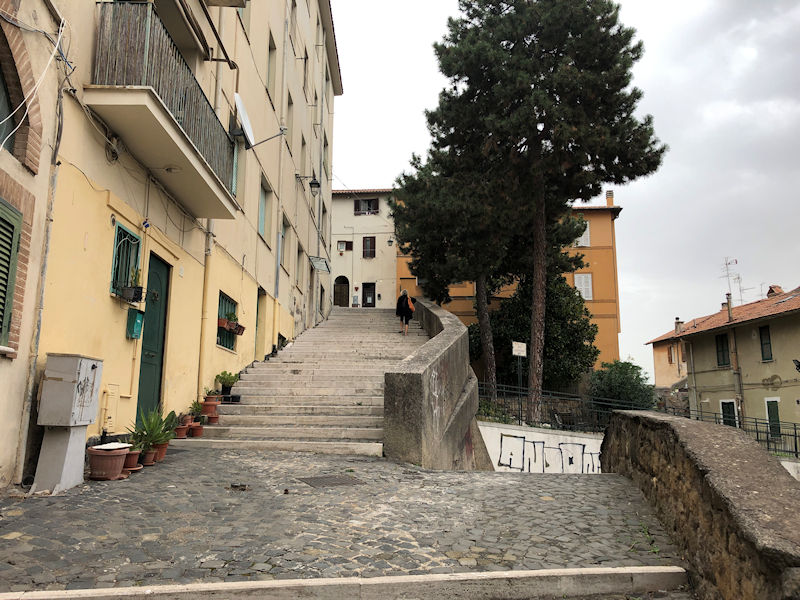
Still up
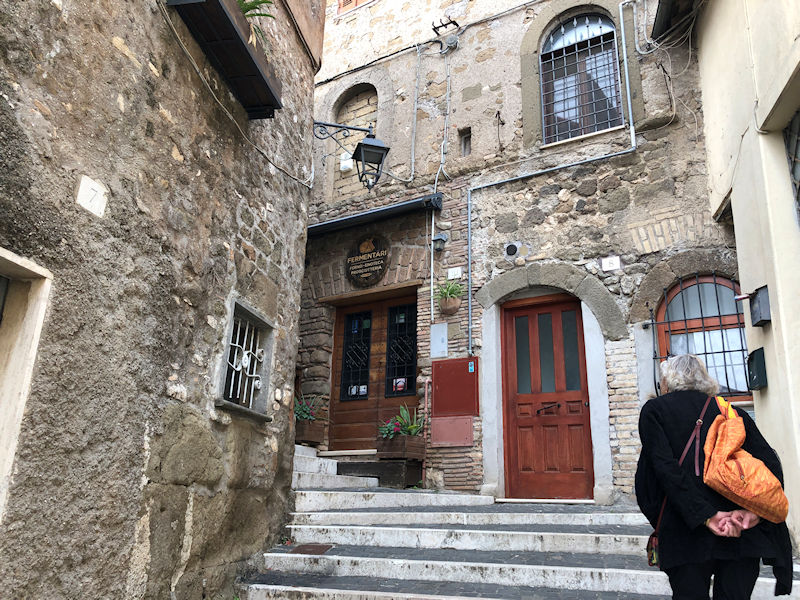
Still on the Via Thomas Mann, still up

Up
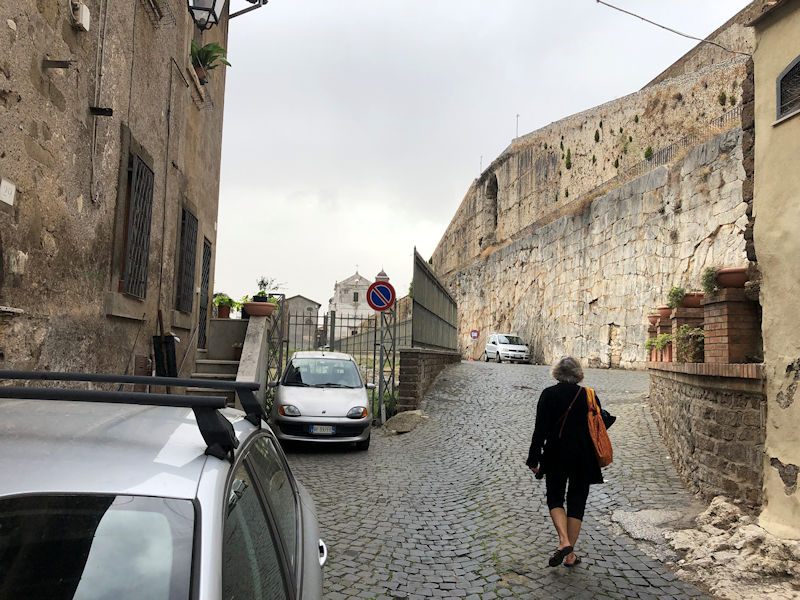
Onto the lateral Via del Borgo, which before the 20th century bombings uncovered so much of it, just below the lowest terrace of the Fortuna Primigenia sanctuary, was apparently the medieval ghetto, with its own synagogue, later converted to a hospital after the Jews were expelled under Pope Pius V Ghisleri in 1568.
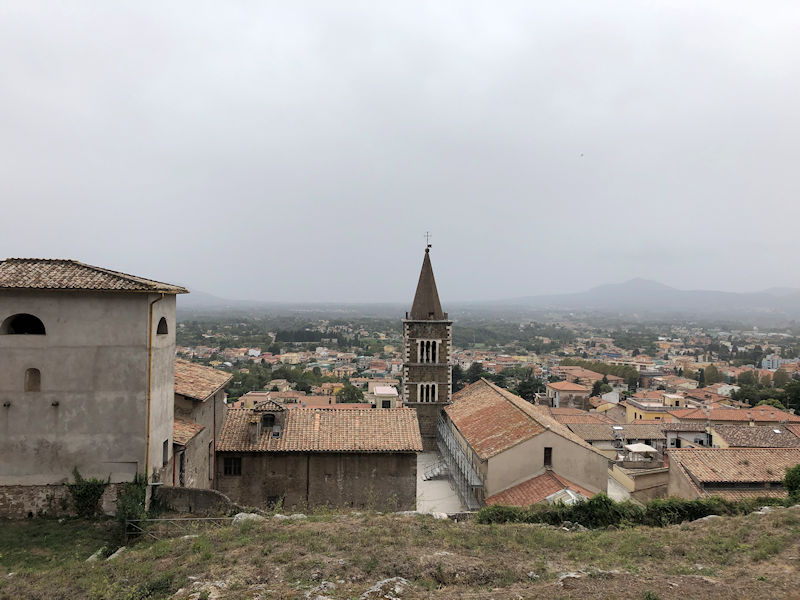
The cathedral and ancient basilica below
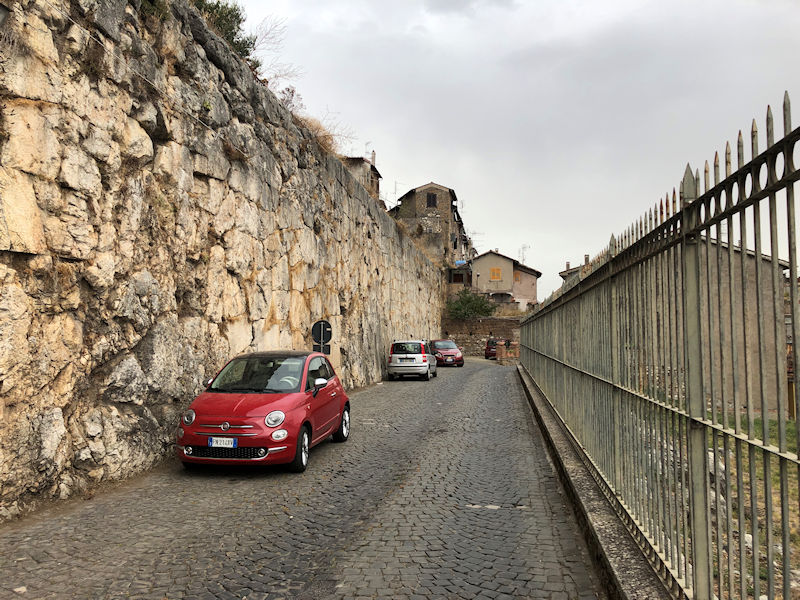
The Via del Borgo, with a helpful guardrail. The original Sanctuary of Fortuna Primigenia was accessed from this terrace with a processional path stretching upwards from here. Below the railing, excavations have uncovered two further terraces linking the Sanctuary with the Forum area below, with fountains modeled on natural caves and another nymphaeum in an artificial cave.
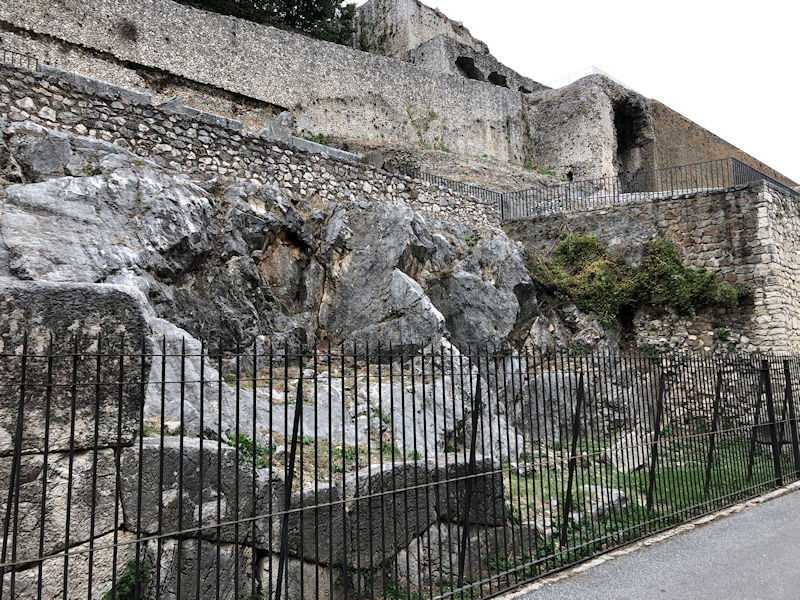
Much of the 1944 ruination here has been memorialized by being preserved and set off by fences. The first ruined tiers of the Sanctuary are ranged along just above.
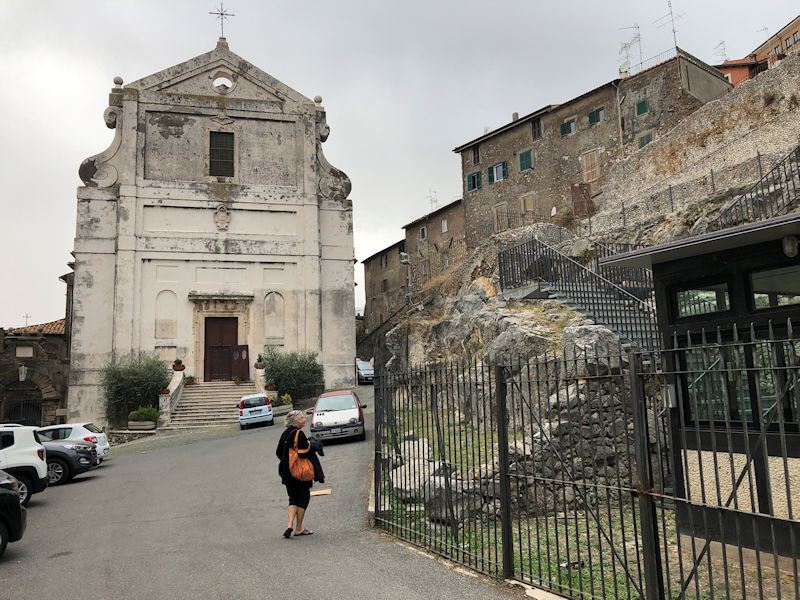
-- Fascinating.

That's the Church of Sant'Antonio Abate (St Anthony the Great, or 'of Egypt'), who was understood to be the Christians' first saint hermit, 'one of the fathers of monasticism' and a friend of domesticated animals, especially pigs. There was an earlier church here but the present one dates from 1626; on the saint's day, 17 January, a procession of floats, animals, and carts starts from the church and parades through the city. It's under the management of the Carmelite Order and could do with a little scrub-up.
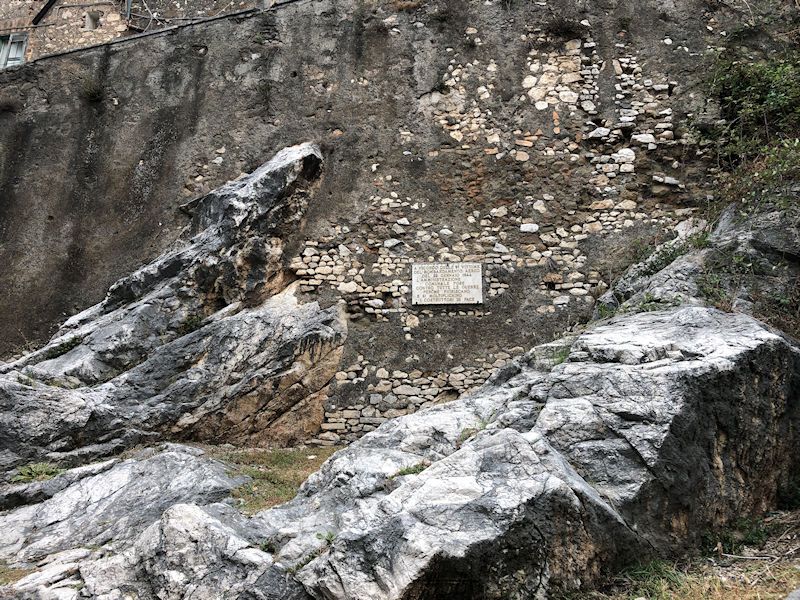
The commemorative plaque translates to: 'In memory of the 91 victims of the aerial bombing of 22 January 1944, the municipal administration posed an opposition to all wars so that peacemakers may flourish and multiply'.
[One writes this caption on the day that Kissinger died.]
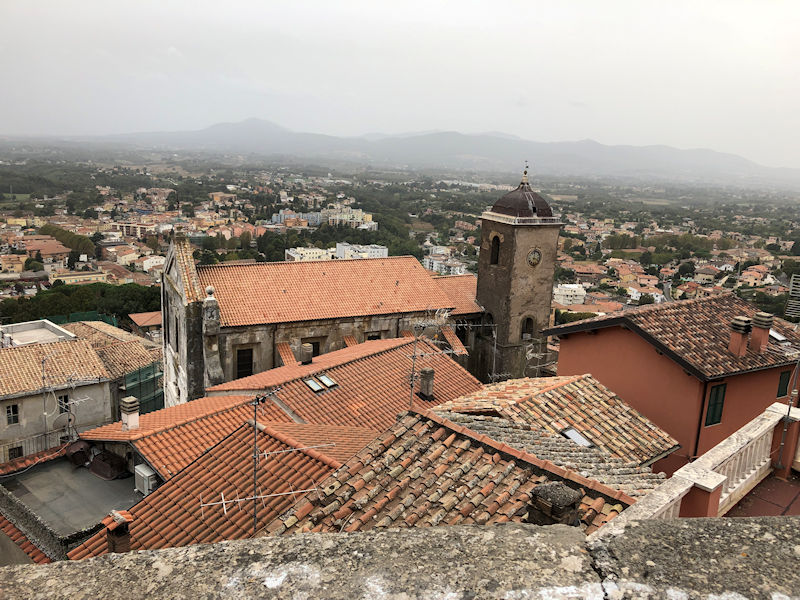
Pausing for a breather, looking back at the Church of Sant'Antonio
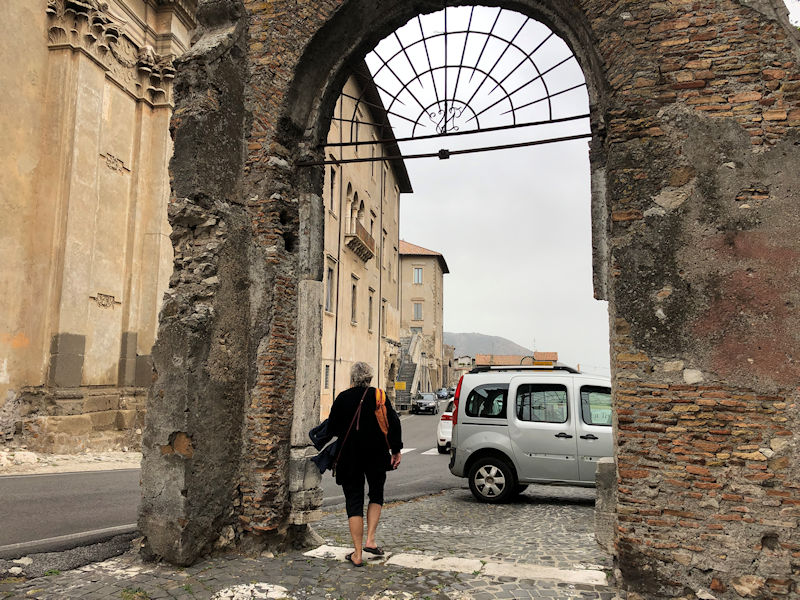
We're now here apparently: the Via Barberini and their palazzo, also called the Palazzo Colonna-Barberini, as it's composed of contributions from both the Colonna family over centuries and the Barberini in the 17th, and perhaps to distinguish it from the family's famous Palazzo Barberini in Rome, completed by Bernini in 1633.
The Barberini were a minor noble family who settled in Florence in the 11th century, and throughout the 16th century became extremely successful merchants in Florence and then Rome. They were able to buy church offices and titles all over the shop, and in 1623 Cardinal Maffeo Barberini was elected as Pope Urban VIII, able to elevate his brother and two nephews as cardinals, another brother as a Duke, and another nephew, Taddeo, who married Anna Colonna in 1627, to call himself the 'Prince of Palestrina'.
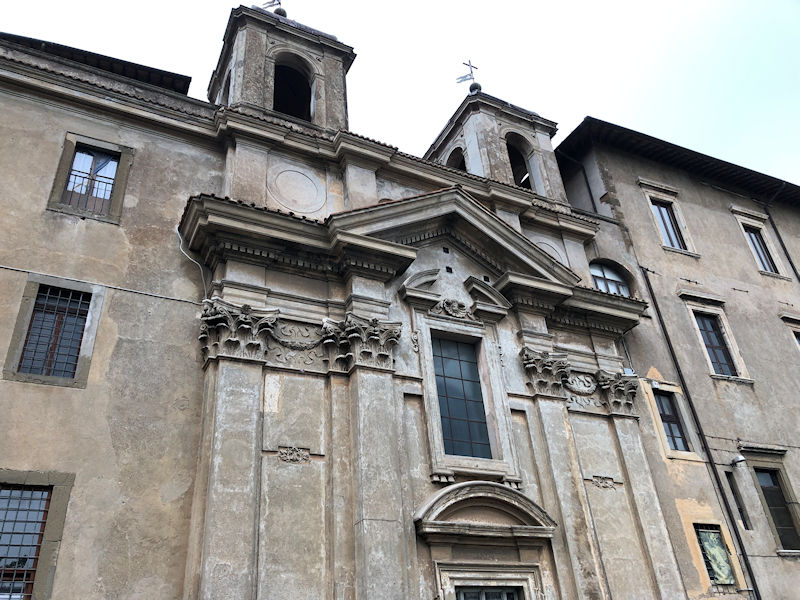
We're dashing, in our enthusiasm, past the Chiesa di Santa Rosalia, opened in November 1660 and dedicated to the saint who had protected the Prenestini (the people of Palestrina) during the plague of 1656. The church, with its twin towers, is said to fit in nicely with the Sanctuary of Fortuna Primigenia and the Palazzo Barberini. Inside the church, the funerary monuments of Taddeo and Antonio Barberini were placed on the side-walls at the beginning of the following century, but we couldn't be bothered with that now.
(The demonym for the present inhabitants can be either Palestrinesi or Prenestini.)
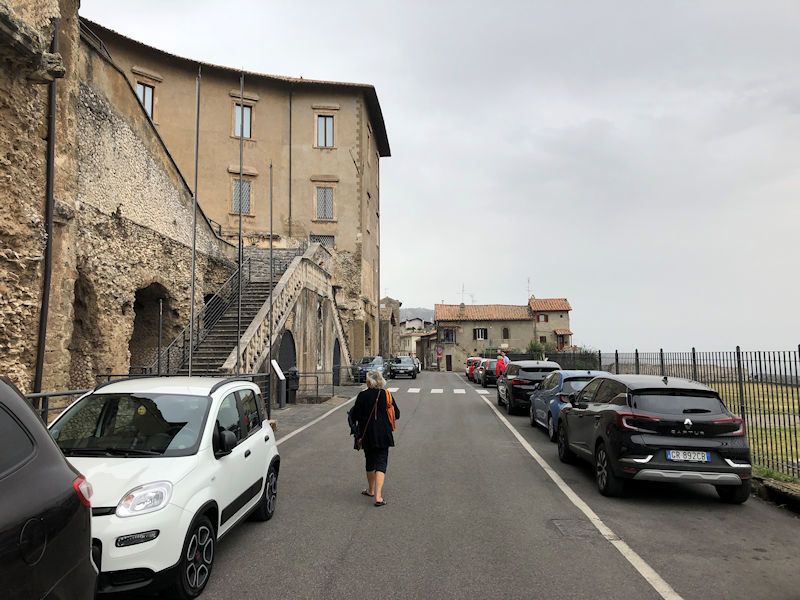
To the front entrance up the stairs, but first . . .
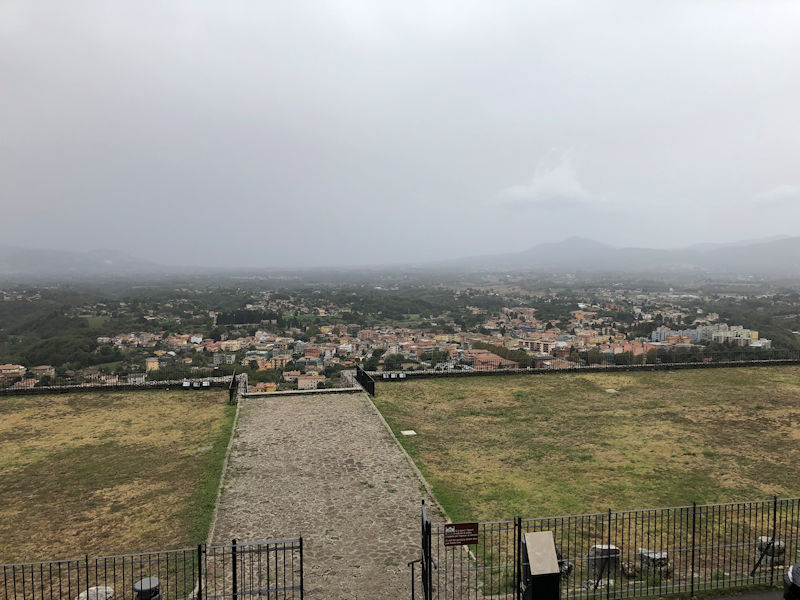
. . . a look from the palace down the terrace levels towards the town.
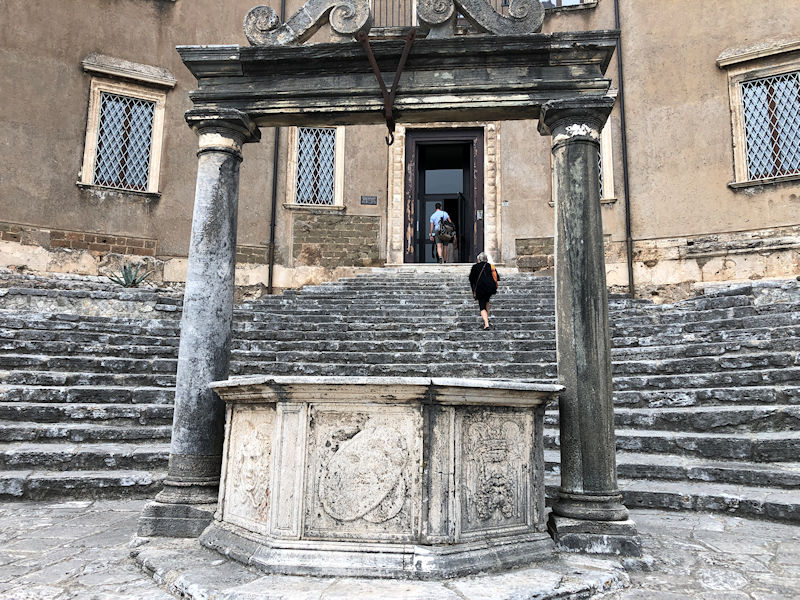
Evidently those are Colonna coats of arms, or perhaps those of both families.
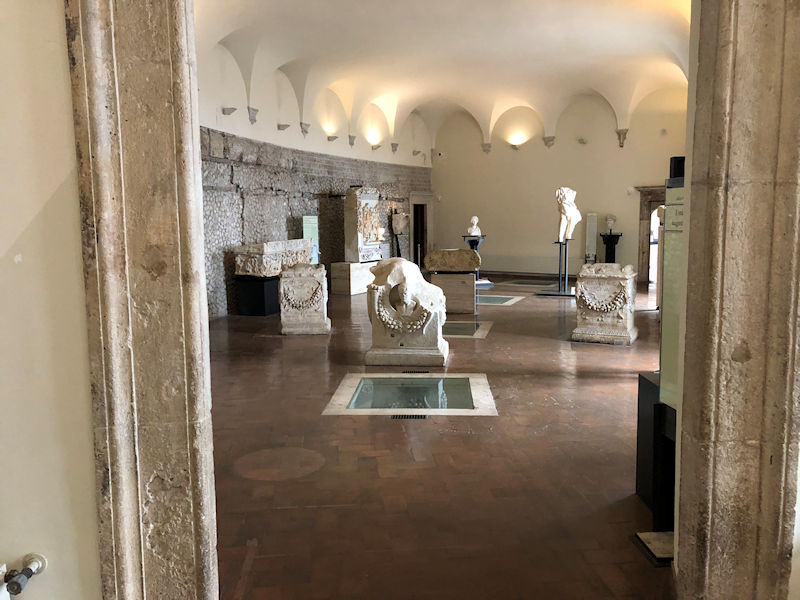
The bomb damage of the War had been largely remedied by 1956, and in the process some ancient structures had been discovered beneath the palace; the palace was given to the Italian state to become the National Museum of Archaeology of Palestrina. The entrance fee is modest, and on this floor there is a range of artifacts from ancient Praeneste; on the second floor, discoveries from the ancient necropoleis around town.
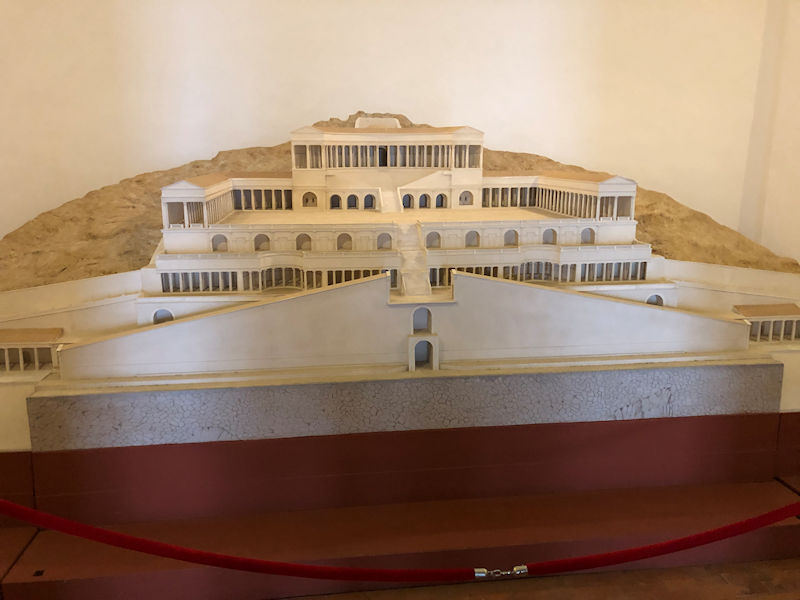
That's a plastic reconstruction of what the original Sanctuary is thought to have looked like.

Lots of the usual Roman era survivals, and . . .
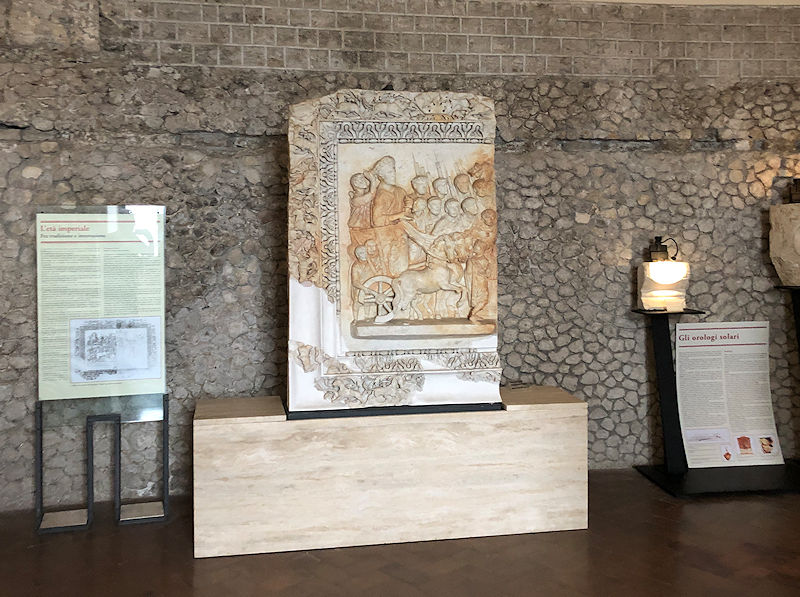
. . . lots of educational panels in Italian and English.
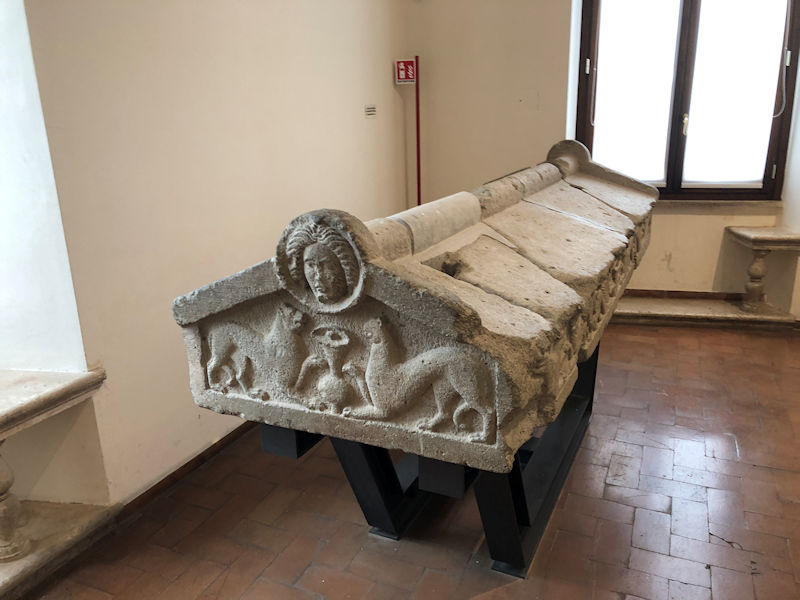
And on the second floor, lots of burial-related odds and ends, like this tomb lid . . .

. . . and these cute tomb markers (on the right).


All kinds of mosaics all over the place, but most especially . . .
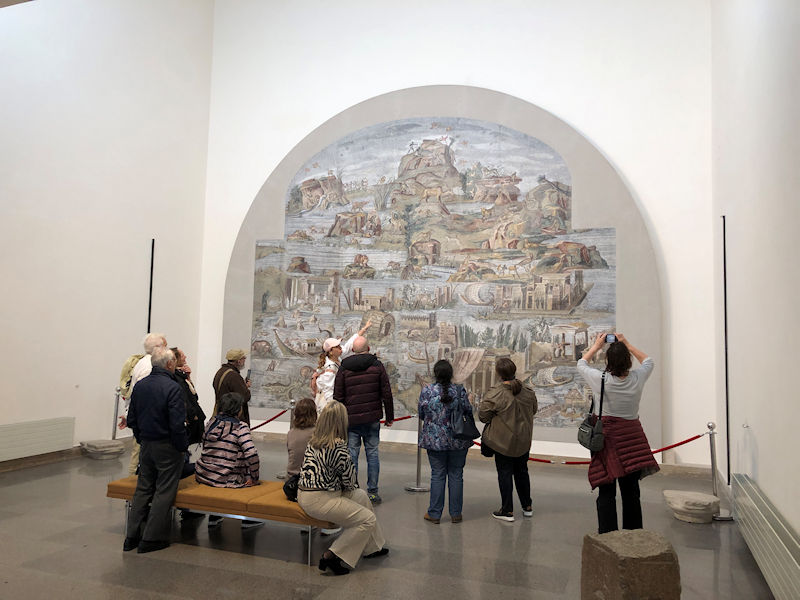
. . . on the small third floor, this one, justly famous, recovered from the floor of a building down in the forum and reassembled up here, vertically, Il mosaico del Nilo, the mosaic of the Nile.
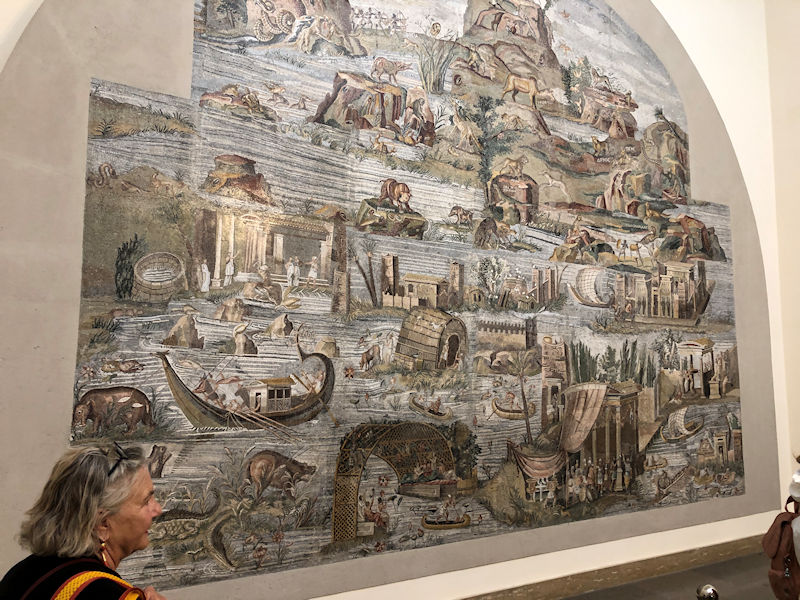
There is said to have been a growing fascination in 1st century BC Rome for exotic Egyptian scenes, and this is thought to be 'the earliest Roman depiction of Nilotic scenes, of which several more were uncovered at Pompeii' (Wikipedia). It tracks, north to south, the Blue Nile course from Ethiopian hunters at the top to activities round the river's course into the Med. The fascination with Egypt scenery and culture agrees chronologically with the spread of Egyptian cults in Italy, when Isis was identified with the Roman goddess Fortuna, the patroness of this sanctuary.
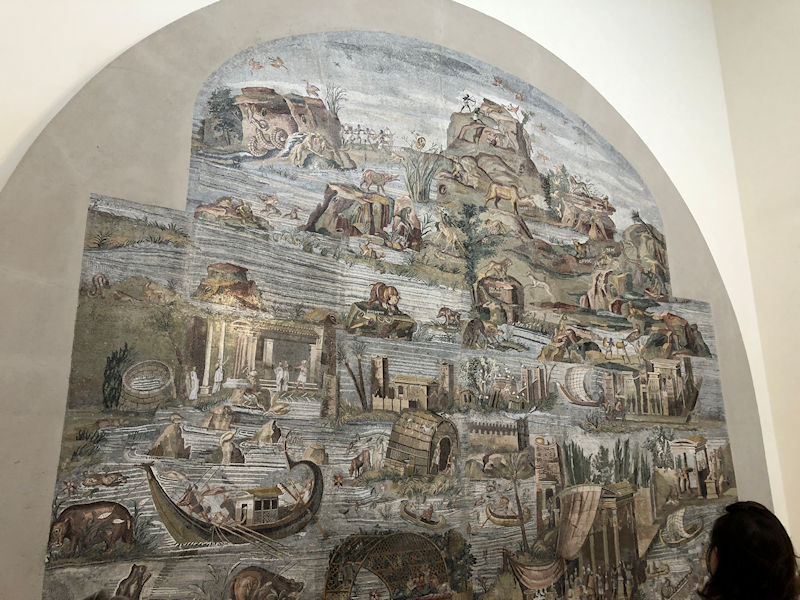
The projecting curve top of it is inherited from the fact that it was originally placed on the floor of the apse of a ceremonial grotto.

The amazing mosaic is thought to have been created here by Egyptian craftsmen in about 100 BC.
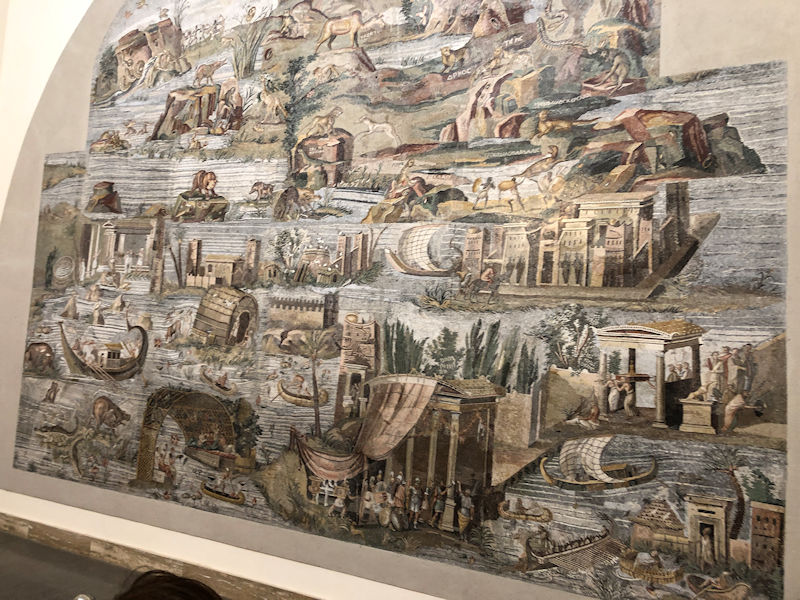
The Nile Mosaic, and the Fish Mosaic down in the Basilica, were still to be seen here in 1507 among the remains of the Sanctuary, which was owned by the Colonna family. In 1624-1626 the Barberini, who'd just moved in, removed it from its setting and put it on exhibition here in their palace. They failed, however, to record the overall composition, and what we have now is a reconstruction based largely on analysis of matching watercolors. It was first put on display here in 1953.
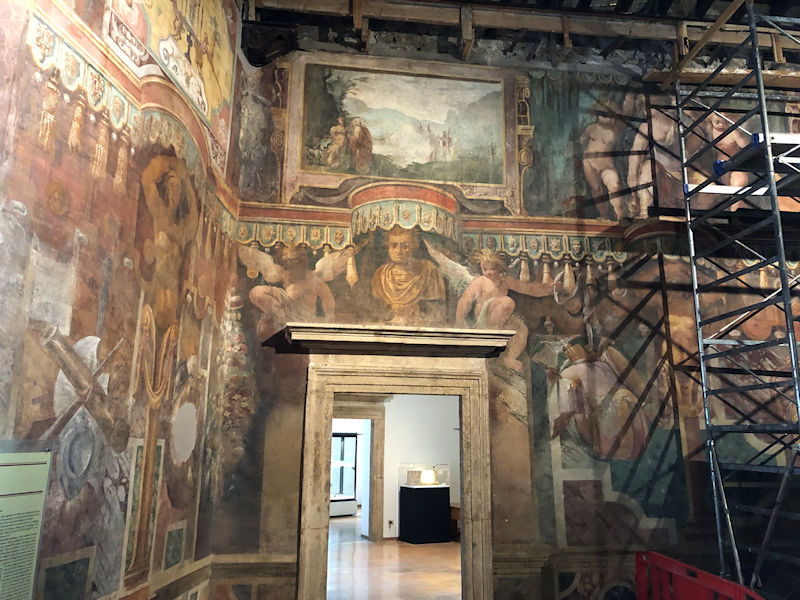
Other rooms in the palace have been frescoed rather unimpressively by what's been described as 'Zuccari's circle', presumably meaning late 16th and early 17th centuries.

Ooof. Take it or leave it.
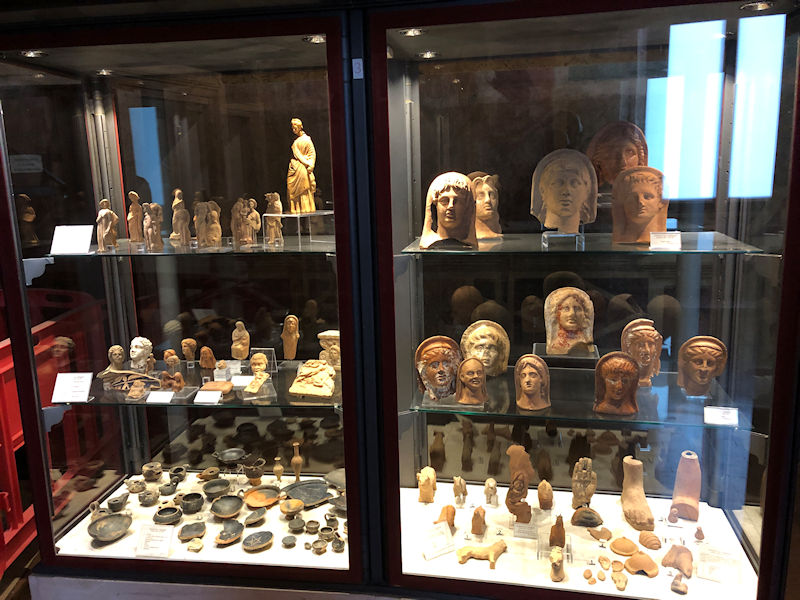
Cute little votive offerings
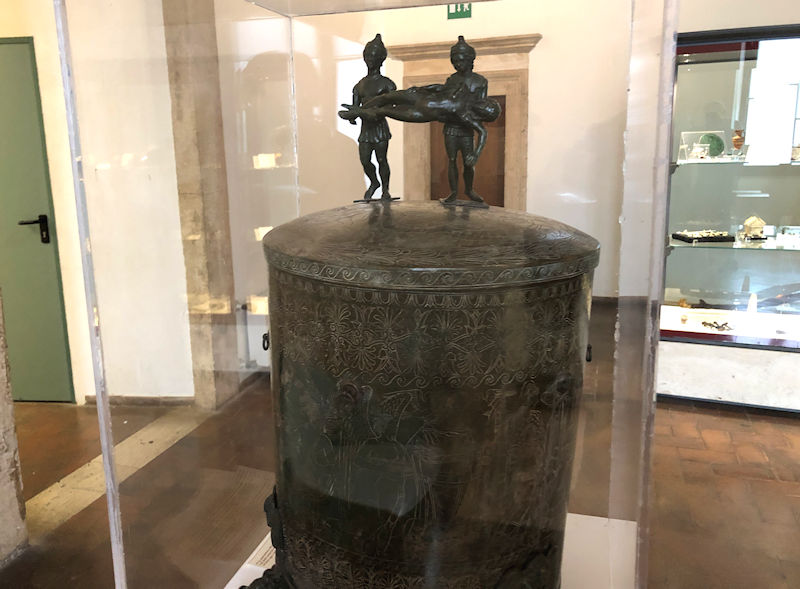
A funeral cista, useful for packing bodies into for burial or holding sacred paraphernalia, or even ladies' cosmetics; this one is very like the famous Ficoroni Cista found in a necropolis near Palestrina but now in the Museum of Villa Giulia in Rome.
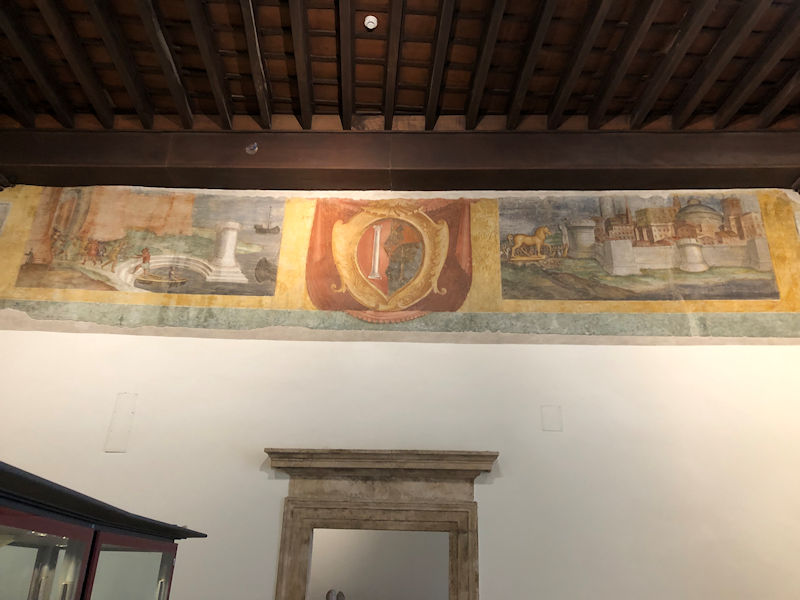
That's pretty feeble.
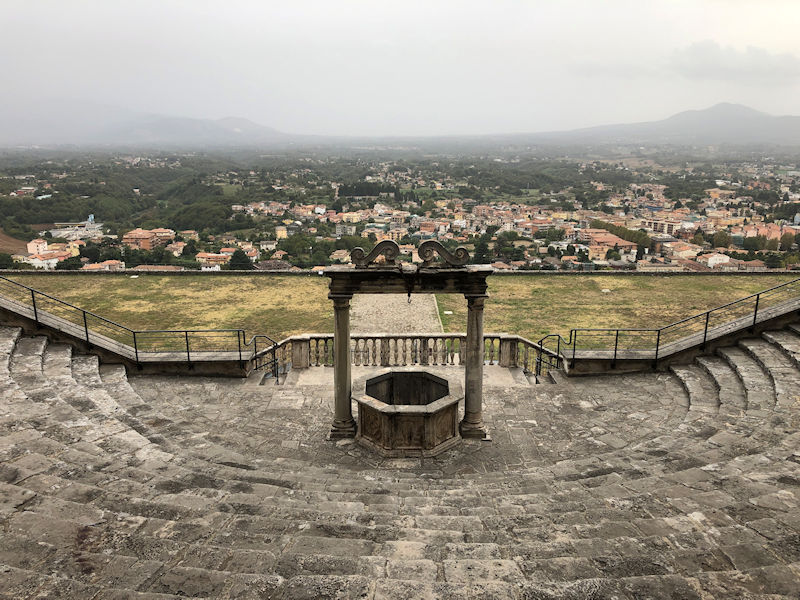
Time to leave -- down to the well and across the Via Barberini . . .

. . . to peek a little farther down, but then become fatigued and ready to start for home, which . . .
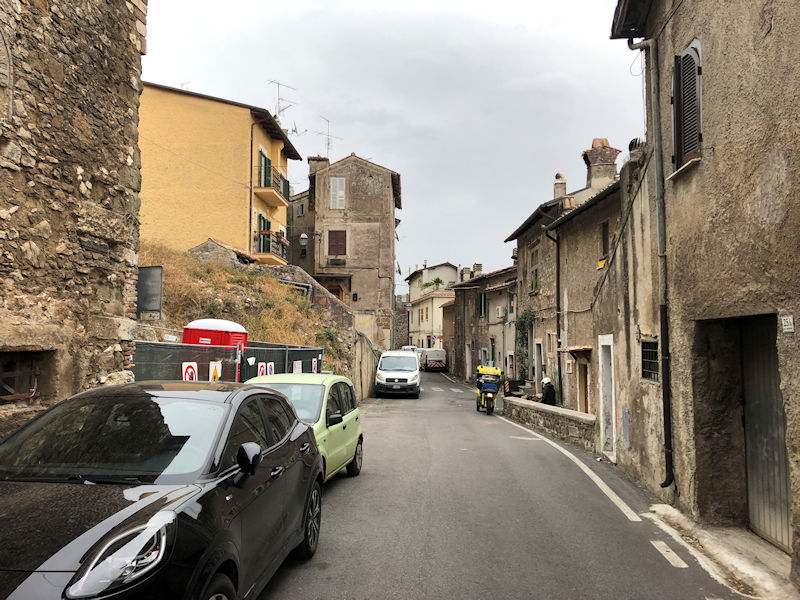
. . . may depend on figuring out how to get down out of here now.
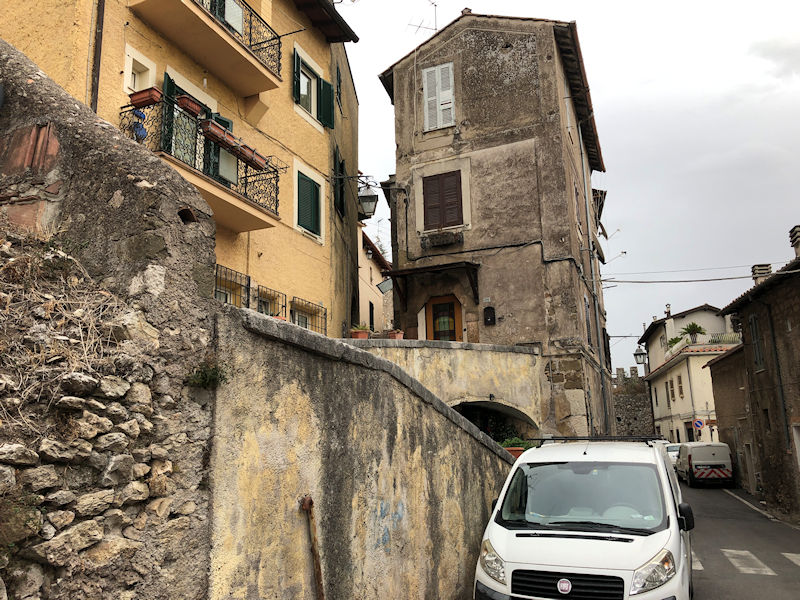
Street scene, with . . .
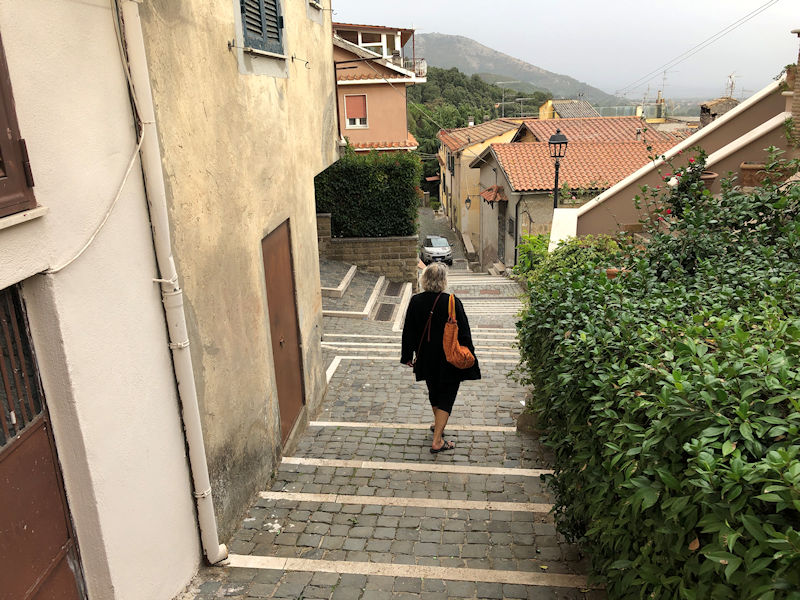
. . . a convenient set of stairs.

We're bound now for a nightmarish wander all round the darkening countryside with no roadmap and precious few intelligible road signs. But in the end we made it, so no hard feelings, well maybe . . .
But before leaving Palestrina, it's worth pointing out that Garibaldi's Legion beat the trousers off a vastly larger Neapolitan army here in May 1849.
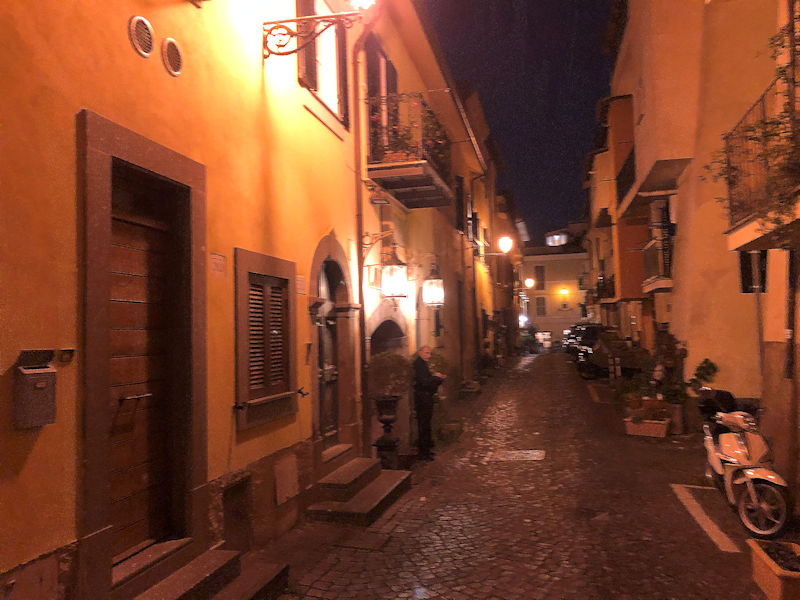
Dinner tonight at the Papessa, with (as every night) a gentleman positioned in the street to guide us down to the good stuff.
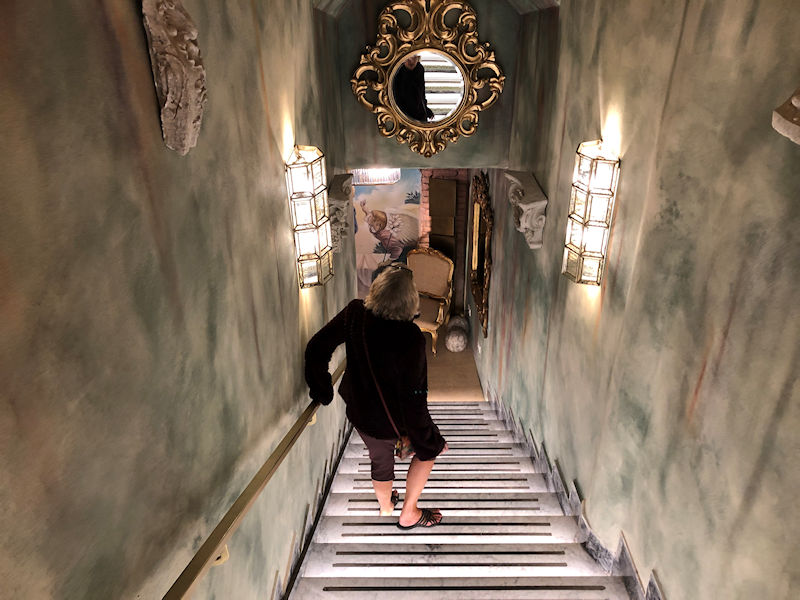
Can't wait
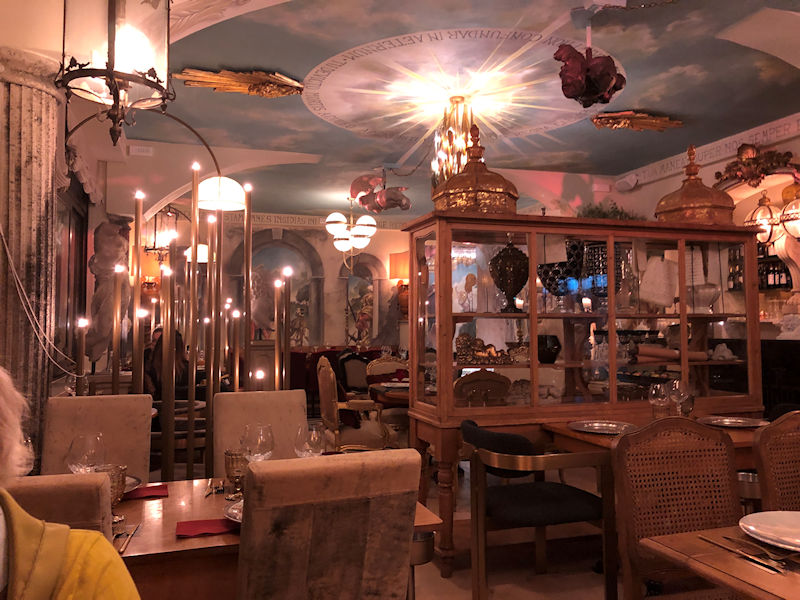
And, as usual at our preferred dinnertime, it's virtually empty (but will be filling up nicely as we're leaving).
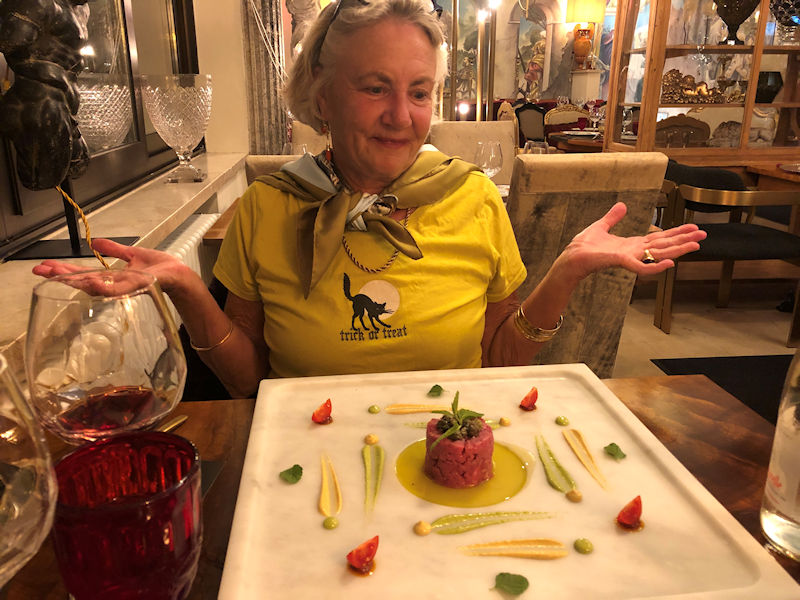
Artistic carpaccio
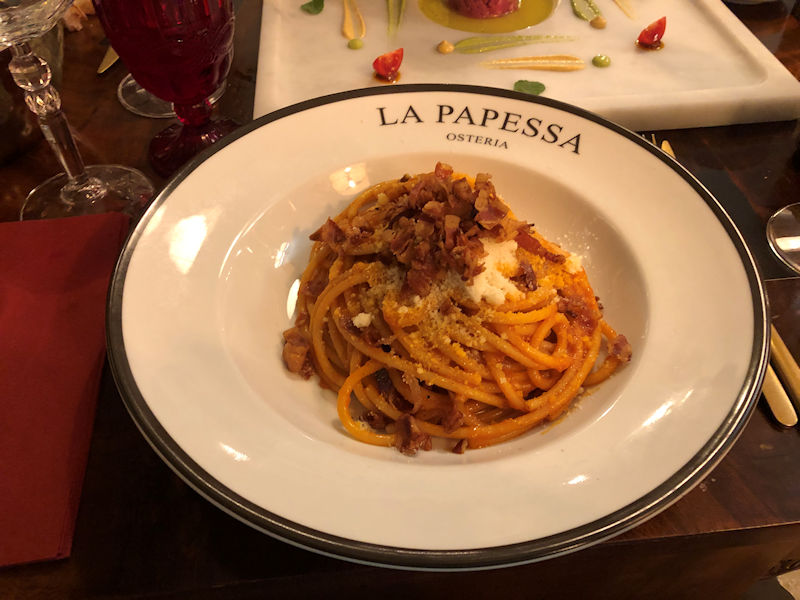
Yum. And later, amaro (Da Capo)
Next up: Last days in Castel Gandolfo


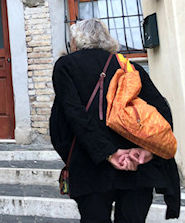 Dwight Peck's personal website
Dwight Peck's personal website








































































